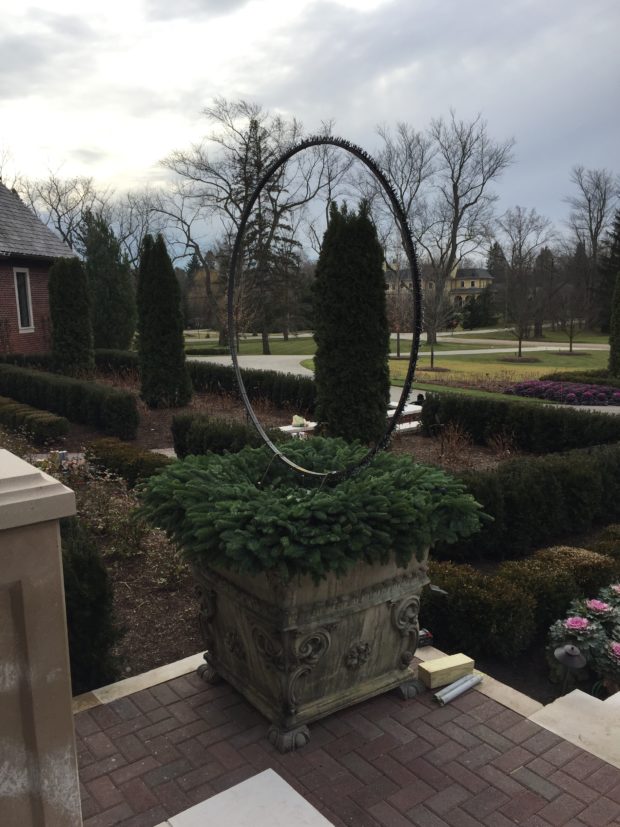 If you’ve frequented Detroit Garden Works during the winter/holiday season in the past 4 or 5 years, you’ve seen Rob’s light rings. Inspired a number of years ago to wrap a trio of vintage grooved wagon wheels with string lights, he went on to design and have manufactured steel hoops specifically engineered to light the winter night with circles of light. Our clients responded in kind. He has had plenty of fans, both residential and commercial, purchase his light rings over the years. Heavy gauge steel channel of an appropriate depth is rolled into a circle and welded. His first rings, produced in a number of different sizes, were designed to be hung from a stout branch of a tree, or in a window. Each ring comes with a generous width and length of jute rope as a hanging apparatus. The plug end of the light strand (or strands, in the case of the really large hoops) was concealed within the jute. An exterior rated extension cord ran up the back side of the tree trunk, and was plugged into the lights from the top. This is his ingenious way of concealing the cord. Some large hoops hung in trees were stabilized with heavy weight fish line attached from the sides of the hoop to neighboring anchor branches to prevent them from swinging in windy weather. A year later, he came out with spiked light hoops, that could be inserted into the ground, or into a pot. The bottom of that spiked hoop is welded to a steel rectangular base. Detroit Garden Works places so many of his lighted hoops in both commercial and residential settings. I greatly appreciate the opportunity to specify them for an installation. We had occasion to install a pair of 5′ diameter spiked light hoops in some large pots this past week.
If you’ve frequented Detroit Garden Works during the winter/holiday season in the past 4 or 5 years, you’ve seen Rob’s light rings. Inspired a number of years ago to wrap a trio of vintage grooved wagon wheels with string lights, he went on to design and have manufactured steel hoops specifically engineered to light the winter night with circles of light. Our clients responded in kind. He has had plenty of fans, both residential and commercial, purchase his light rings over the years. Heavy gauge steel channel of an appropriate depth is rolled into a circle and welded. His first rings, produced in a number of different sizes, were designed to be hung from a stout branch of a tree, or in a window. Each ring comes with a generous width and length of jute rope as a hanging apparatus. The plug end of the light strand (or strands, in the case of the really large hoops) was concealed within the jute. An exterior rated extension cord ran up the back side of the tree trunk, and was plugged into the lights from the top. This is his ingenious way of concealing the cord. Some large hoops hung in trees were stabilized with heavy weight fish line attached from the sides of the hoop to neighboring anchor branches to prevent them from swinging in windy weather. A year later, he came out with spiked light hoops, that could be inserted into the ground, or into a pot. The bottom of that spiked hoop is welded to a steel rectangular base. Detroit Garden Works places so many of his lighted hoops in both commercial and residential settings. I greatly appreciate the opportunity to specify them for an installation. We had occasion to install a pair of 5′ diameter spiked light hoops in some large pots this past week.
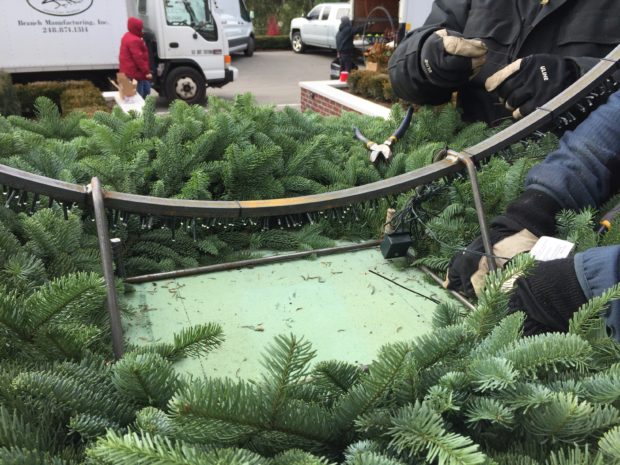 In this picture, the spikes at each corner of the frame have already been pushed down through the foam form which had previously been stuffed with greens in the shop. Given the size of these hoops, steel rebar was pounded down into the soil at all four corners of the hoop base. Each piece of steel went deep into the soil in the pot, and is secured to the hoop framework at the top of the base with steel concrete wire.
In this picture, the spikes at each corner of the frame have already been pushed down through the foam form which had previously been stuffed with greens in the shop. Given the size of these hoops, steel rebar was pounded down into the soil at all four corners of the hoop base. Each piece of steel went deep into the soil in the pot, and is secured to the hoop framework at the top of the base with steel concrete wire.
 Securing the hoops take some time, but my idea is any element in a winter pot that goes sideways in bad winter weather is a poor look indeed. I like winter containers whose every element persists, in spite of whatever the winter weather has to dish out. That these lighted hoops will remain in place the entire winter is the best reason to make sure they stay put. Our winter weather can be nasty as well as inhospitable. Winter containers that endure are beautiful. Lighting the landscape via winter container arrangements is a good idea. Our winters are gray and blah – visually tedious. Some light and some warmth makes everyone feel better. That light makes the winter landscape look better.
Securing the hoops take some time, but my idea is any element in a winter pot that goes sideways in bad winter weather is a poor look indeed. I like winter containers whose every element persists, in spite of whatever the winter weather has to dish out. That these lighted hoops will remain in place the entire winter is the best reason to make sure they stay put. Our winter weather can be nasty as well as inhospitable. Winter containers that endure are beautiful. Lighting the landscape via winter container arrangements is a good idea. Our winters are gray and blah – visually tedious. Some light and some warmth makes everyone feel better. That light makes the winter landscape look better.
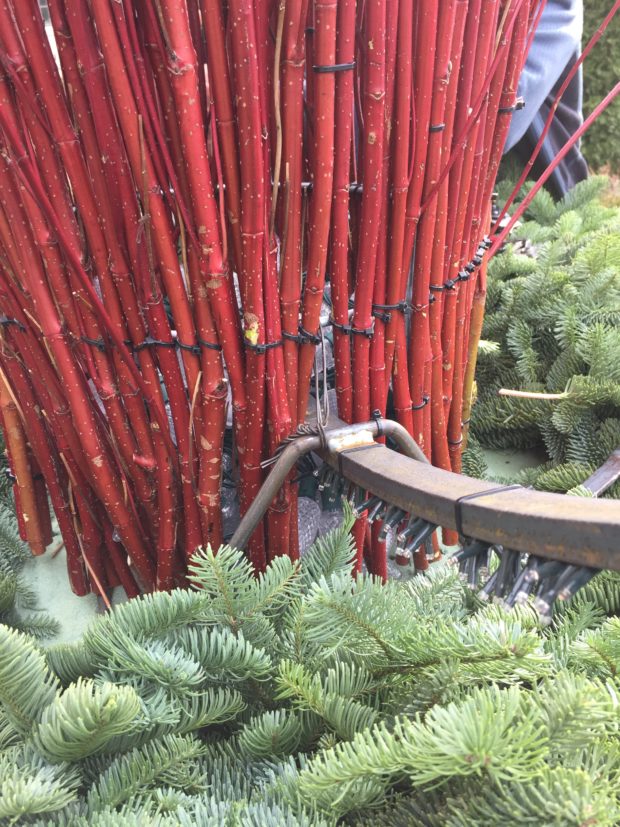 The red twig dogwood was secured to a tomato cage in a way similar to a previous project. We did have to remove the bottom ring from this tomato cage so the dogwood and cage would fit over the bottom portion of the hoop. I have the Branch staff to thank for their adaptation that made this installation work. The middle ring of the tomato cage is attached to the base assembly of the hoop with more concrete wire.
The red twig dogwood was secured to a tomato cage in a way similar to a previous project. We did have to remove the bottom ring from this tomato cage so the dogwood and cage would fit over the bottom portion of the hoop. I have the Branch staff to thank for their adaptation that made this installation work. The middle ring of the tomato cage is attached to the base assembly of the hoop with more concrete wire.
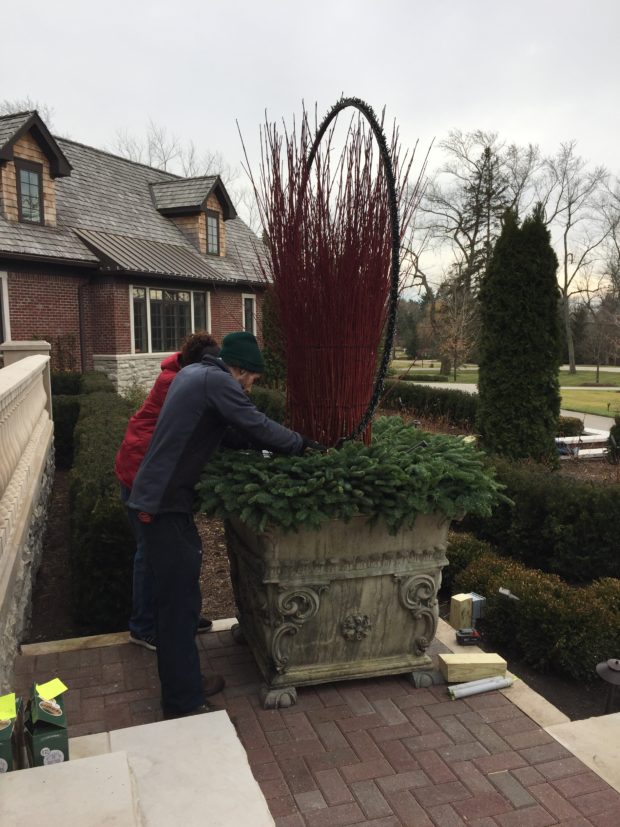 A 50 light strand of C-9 LED lights was installed inside the funnel of dogwood. It is remarkable how much this gesture adds to the glow. Someone once said that the difference between very good and stellar in any gesture amounts to about 10 percent. This additional string of lights is a gesture aimed at stellar.
A 50 light strand of C-9 LED lights was installed inside the funnel of dogwood. It is remarkable how much this gesture adds to the glow. Someone once said that the difference between very good and stellar in any gesture amounts to about 10 percent. This additional string of lights is a gesture aimed at stellar.
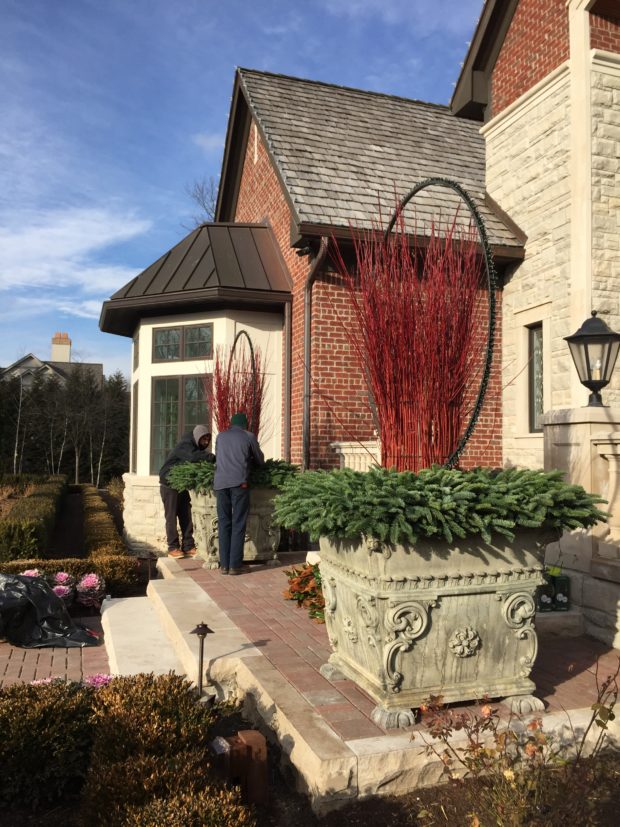 Once the centerpieces were set, several more layers of materials would be added. Those intermediary layers soften the intersection of the vertical centerpiece, and the horizontal blanket of greens. That intersection needs some intervention. Though our winter containers are engineered, they don’t need to look like it. An installation of this scale asks for thoughtful construction, but the look needs to be graceful and natural. Additional layers are cozy and warm. These boxes measure 40″ by 40″ on the outside. This is a very large space, calling for appropriately sized containers. They look like they are the right size in this environment. Only when people are photographed next to these pots do you realize how large they are.
Once the centerpieces were set, several more layers of materials would be added. Those intermediary layers soften the intersection of the vertical centerpiece, and the horizontal blanket of greens. That intersection needs some intervention. Though our winter containers are engineered, they don’t need to look like it. An installation of this scale asks for thoughtful construction, but the look needs to be graceful and natural. Additional layers are cozy and warm. These boxes measure 40″ by 40″ on the outside. This is a very large space, calling for appropriately sized containers. They look like they are the right size in this environment. Only when people are photographed next to these pots do you realize how large they are.
 A layer of red berry picks were inserted into the foam base. The height of these berries conceal the top ring of the tomato cage, and the zip ties that hold the dogwood to the form. Bring on the red! Oh yes, these are faux berry stems. They will see service for a number of years, unfazed by the sun or the winter weather.
A layer of red berry picks were inserted into the foam base. The height of these berries conceal the top ring of the tomato cage, and the zip ties that hold the dogwood to the form. Bring on the red! Oh yes, these are faux berry stems. They will see service for a number of years, unfazed by the sun or the winter weather.
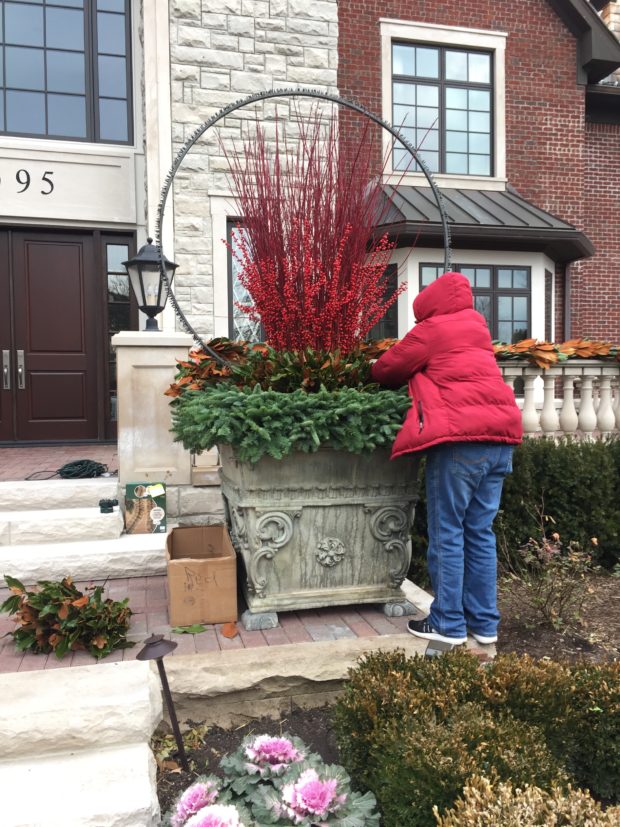 A final layer of tall fresh cut magnolia branches cover the lowest ring on the dogwood form. The large size of these glossy green leaves is an effective contrast to the smaller texture of the other elements. Magnolia is one green that dries beautifully. That dark green will fade to a beautiful pale green, and the reverse side of each leaf will hold its cinnamon brown color for a long time.
A final layer of tall fresh cut magnolia branches cover the lowest ring on the dogwood form. The large size of these glossy green leaves is an effective contrast to the smaller texture of the other elements. Magnolia is one green that dries beautifully. That dark green will fade to a beautiful pale green, and the reverse side of each leaf will hold its cinnamon brown color for a long time.
The lights in the greens come last. Each small dot of light sits atop a dark green stalk which is easily an inch long. That stalk is attached to base of wire. We thank the Dutch for these well designed light strings. Their longest strand is 110 feet, and features 1500 lights. Their design makes it possible to have the wiring and stalks set into the greens and out of sight, with just the dots of light on top. We lay the light strands on the surface until there is a pattern and coverage we like. When their are multiple pots, the same person does the layout for all. This makes for a consistent appearance from pot to pot. This may seem like a very small and unimportant gesture, but it does in fact contribute to the overall formality and quality of the installation. Though many hands take part in most of our projects, the finish needs to look focused and polished.

Once the lighting is arranged, we tuck in as much of the wire and light stalks as possible. Our daylight begins to fade at 4pm this time of year, and dawn straggles in about 8am. The challenge of winter pots is to design them them to work both day and night. All of the day time materials need to be natural and believable. A mechanism by which the pots can be appreciated at night is a big plus.
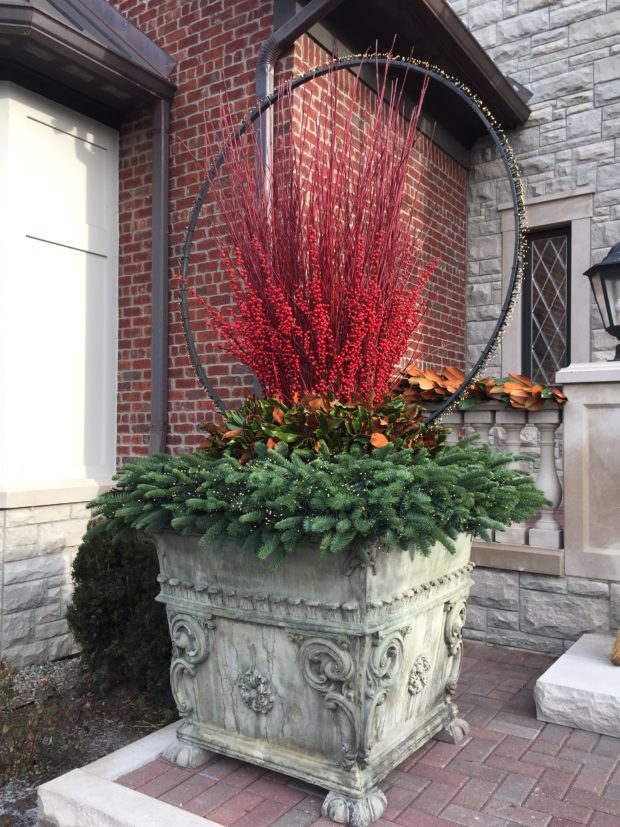
This finished container was photographed during the day. As for the size and scale of this container, I can assure you that two of my staff people were behind this pot, hooking up the final electrical. I am not surprised that I cannot see them. I am satisfied that we addressed the issue of scale and proportion accurately.
 This late afternoon photograph was taken by my client. She is a passionate photographer, among a whole host of other things, including a keen interest in the landscape and garden. I love this picture from her. It tells me she feels like she got what she was looking for. The result pleases the both of us.
This late afternoon photograph was taken by my client. She is a passionate photographer, among a whole host of other things, including a keen interest in the landscape and garden. I love this picture from her. It tells me she feels like she got what she was looking for. The result pleases the both of us.
Those pots!!! oh geeze, I feel love sick over this….sigh. I just have no more words for the creative brilliance of you Ms. D. Silver.
Warm and elegant. . . Love it!
Magnificent!! Once again I am amazed by the beauty you create.
Gorgeous! Where does he find those lights?
OUTSTANDING !!!!
Stunning and inspirational as always. I wish I lived closer to you and had the means to contract your services. I wouldn’t be disappointed, ever. Merry Christmas to you and your talented team and all the best in the New Year.
Once again I am in awe. Each season comes with more ingenious ideas of magnificent proportion. You Deborah, and Rob, are a gift to your clients and your readers. Thank you for sharing so generously
Debra
Dear Debra, Rob and I make a point trying to up our game every year. We are not the least bit shy about sharing that evolution with other gardener and landscape professionals. Every gardener and landscape professional that takes from what we do to endow what they do means our work is meaningful. I hope I have expressed this clearly. Any part we can contribute to better gardening is a place we want to be. best regards, Deborah
would love to see this at nite when only small lites show with ring. beautiful, your works ALWAYS inspire me! Thank you, Eileen
Fab-u-lous!!! Thank you for sharing your brilliant work! I would love the see this display after dark.
Using hoops is a great idea. Very unusual.
Oh my word! I feel exhausted just looking at all the detail put into producing those two pots. 🙂 You and your staff are to be admired and commended for the dedication and attention to detail in achieving such wonderful end results. On the 4th photo showing how the red twig dogwood was secured to the tomato cage, it hit me that all this took a great deal of work and time and I know I would have been exhausted. Madam Silver my hats off to you and ur staff…..just wonderful!!!
Dear Maxx, there is indeed a lot of work that goes in to all of our projects. We all take that work in stride. best regards to you, Deborah
Your designs are so inspiring!
Dear Rhonda, my blog is a journal of the work I do all year long. If you are inspired to apply what I write to your garden, I am pleased. best regards, Deborah
Deborah,
So so beautiful! I have purchased noble branches from my nursery and have also bought a Christmas tree and carefully cut the branches myself. I can never seem to get them as even in length or as fluffy. Where do u get such large and full noble branches? Mine have already dried up and I have watered and sprayed with wilt proof…??? Help! Thanks! Nicole
Wow Wee! Just amazing and oh, so beautiful!
“Red twig dogwood was secured to a tomato cage.” Thanks so much for sharing this tip and showing how each twig is secured to the cage. Will definitely be using this next year.
Do you sell the rings ?
Dear Susan, we will have them again later in the fall. best, Deborah